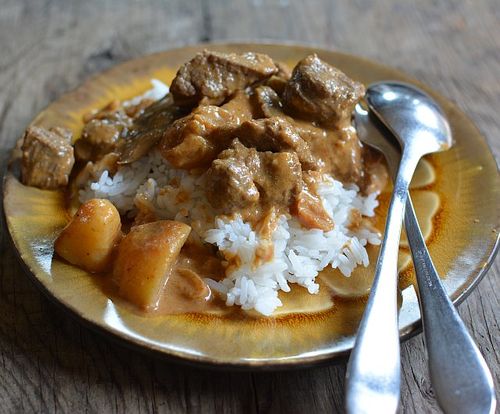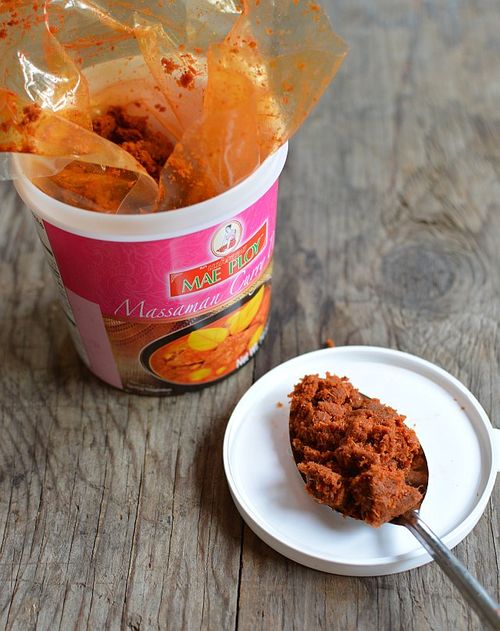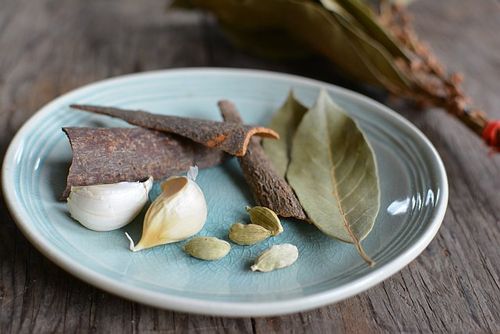
I don’t know when I first had Thai massaman curry but I instantly fell in love with its layered spicy tang and rich flavor. According to David Thompson in Classic Thai Cuisine, the curry may have came from Persia, “probably arriving with Muslim courtiers who were attached to the Siamese court.” In Thai Food, he says that it could have also come from southern Thailand by way of Muslims who arrived with Indian or Arab merchants and traders.
Imagine ideas from the Middle East flowing to the Southeast Asia and flourishing. That is what massamam curry embodies. It’s not overly spicy or too sweet. Just right. And there are often chunks of potato and bits of roasted peanut to add interesting texture. It’s the most complex and time-consuming to make, Thompson says.
I’ve made my own massaman (also spelled as matsaman or mussaman) curry paste in the past but didn’t have the energy to whip it up over the weekend. Instead, I doctored up store-bought paste. There are instructions on the package by Mae Ploy but I’ve never done well with its simple instructions. Pre-made curry paste are convenient but they are one or two-dimensional. How to add extra dimension to come closer to the real, freshly made stuff?
Check a reliable cookbook! I perused Thompson’s recipes in Classic Thai Cuisine and Thai Food. I also looked at what Leila Punyaratabandhu suggests in Simple Thai Food. The approaches were similar and called for tough, stewy cuts like shank and flank. Rich tasting shank takes a good 2 hours to cook so I opted for chuck. The curry often includes cassia bark and other spices, along with paste; that is something that the Mae Ploy curry paste instructions do not tell you.
I decided to take that route to amplify the paste but also add a few spices that Thompson included in the massaman curry paste recipe in Classic Thai Cuisine. He also uses roasted aromatics such as shallot and garlic. I opted to toast a couple garlic cloves along with the spices; my large shallots seemed like they'd be a pain in the butt to roast.
My goal was to take a shortcut to refreshing the purchased paste. It worked like a charm. If you don’t have the spices around, don’t add them. However, this was among the best massaman curries I’ve prepared from storebought paste. It made enough for us to for two dinners and one light lunch. We ate it with rice and a salad or boiled broccoli.
The protein can vary with this curry so you could use lamb, duck, chicken, etc. Or go vegetarian with lots of potato and fried tofu; use fish sauce or soy sauce to season depending on your level of vegetarianism. Adjust cooking time and water as needed.
How do you use store-bought Thai curry pastes? Brands you like?
RECIPE
Smart Cheater’s Beef Massamam Curry
Gaeng Massamam
Yields: 4 to 6 servings
Ingredients
- 1 (14 oz /400 ml) can coconut milk
- 1 tablespoon unrefined coconut or canola oil, plus more as needed
- About a racquetball size chunk of matsamam curry paste (⅓ cup / 90 ml)
- ⅛ to ¼ teaspoon ground white pepper, optional
- ¼ to ½ teaspoon ground coriander, optional
- Pinch of ground cloves, optional
- ⅛ teaspoon ground nutmeg, optional
- ⅛ teaspoon ground cumin, optional
- Generous 1 ½ pounds (675 g) boneless beef chuck, cut into 1-inch (2.5 cm) chunks
- 3-inch piece cassia bark or 1 cinnamon stick
- 5 green cardamom pods, lightly crushed
- 2 bay leaves
- 2 garlic cloves, unpeeled
- Generous 1 pound (½ kg) red, white or yukon gold potatoes, cut a little smaller than the beef
- 1 small yellow onion, cut smaller than the potato
- 1 to 2 tablespoons fish sauce
- 1 ½ to 2 tablespoons packed shaved light palm sugar or brown sugar
- 1 ½ to 2 tablespoons tamarind liquid/past (see Into the Vietnamese Kitchen or Asian Dumplings for recipe or go here)
- ¼ cup unsalted, roasted peanuts
Method
- Open the can of coconut milk and start pouring it into a measuring cup. If it’s thin and fluid, measure out about 1 cup (240 ml) of it. What remains (about ⅔ cup, 150 ml) will be the thicker coconut cream. If you have thicker cream on top, use a spoon to scoop it out and measure; you’ll have thinner coconut milk left in the can. Set the two separated coconut milks aside.
- Put the coconut cream, oil, curry paste, white pepper, coriander, cloves, nutmeg and cumin in a 3 or 4-quart pot (.75 to 1 L). Bring to a boil over medium-high heat. Cook for several minutes until aromatic and the coconut oil separates a bit. Add the beef, the thinner coconut milk and enough water to just cover. Bring to a boil, reduce the heat to simmer, uncovered, for 1 hour, or until just tender.
- While waiting for things to heat up, in a medium skillet, toast the cassia bark, cardamom pods, bay leaf and garlic over medium heat until fragrant. When the spices reach a fragrant state, add the cassia, cardamom and bay leaf to the pot of beef. When the garlic has softened a bit, remove it from the pan, cool for a few minutes then peel. Smash it with your knife blade, then add to the pot of beef.
- Reuse the skillet. Add oil to film the bottom. Pat the potato dry then fry the potato over medium or medium-high heat until halfway cooked and possibly a little browned, 10 to 15 minutes. Set aside.
- When the beef is ready, add the potatoes, onion, and peanuts. Simmer for 10 to 15 minutes, until the beef, potatoes and onion are soft.
- Season with the fish sauce, sugar and tamarind liquid. Aim to balance the sweet, salty and slightly sour. Simmer for a 5 minutes more, then recheck. When you’re satisfied, turn off the heat and let the curry rest for 10 minutes to meld flavors. Then serve.
Related posts:


















